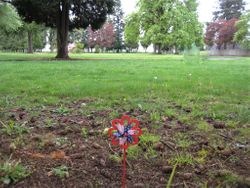By Dave Tucker, Bellingham, WA
Many IWW members are buried in Washington State. Quite a few of these Wobblies were killed early in the 20th Century because they tried to gain improvements on the job or exert their right to free speech in public. Many were murdered by police and capitalist goons. Some are well known within the IWW: the Wobs who died aboard the Verona in Everett in 1916; Wesley Everest, lynched in Centralia in 1919; and William McCay, shot on the picket line in Grays Harbor in 1923. There are many others, mostly unsung and virtually forgotten victims of the class war.
Some of these Fellow Workers lie in unmarked graves. Over the past years, IWW members have tried to locate these unmarked graves through IWW newspapers, cemetery records, newspaper obituaries, and “Find-a-Grave” web pages. Over time we have learned about these men from accounts of their deaths and the events that led to them. These union men are our forebears; they died defending workers’ rights to free speech and to organize.
Poor people often lie in unmarked graves, especially if they have no family or were indigent and buried at the county’s expense. Cemetery records usually have a map showing the plot location, but if a person is buried among other unmarked graves, there are few reference points to use to find the exact location.
In June 2023, Fellow Worker Phil from Seattle joined me for a 5-day road trip to eastern Washington to locate some of these graves. We also paid respects to a couple other Fellow Workers who do have gravestones that have been recently located by IWW members.
We drove first to Vancouver, Washington, to find the grave of Clayton E. “Stumpy” Paine (1869-1963). Fellow Worker Payne was present at the 1905 founding convention of the IWW. Stumpy got his nickname because for a while he tried his hand at “stump-farming” in Idaho, farming a piece of recently logged over land. He wasn’t very successful at it but the name stuck. He largely earned his living as a carpenter and moved around a lot. FW Payne was among the foremost self-taught IWW theorists and a life-long proponent of our goals. He was a frequent contributor to, and eventually editor of, the Industrial Worker. His pamphlets on industrial democracy and organization were widely circulated. Among many other topics, he reported on the Everett Massacre of IWWs in Everett in 1916 and the attack on the IWW hall in Centralia in 1919. He also wrote numerous articles critical of communist party rule in Russia, especially imprisonment of left-wing revolutionaries. This earned him the enmity of American communists, including those in the IWW.
In 1920, while working in Newport, Washington, he was charged with “criminal syndicalism,” which by state law essentially outlawed IWW membership and the concept of worker power on the job. He was convicted and served a year in the state prison at Walla Walla.
After his release, he continued to work in the IWW, serving numerous terms on the Executive Board and as Industrial Worker Editor all the way into the 1950’s.
He resigned from his final term on the board in March 1962, signing off his final report with “So long! And may you all enjoy the good conditions certain to result from intelligent and intense effort.” A year after he resigned from his final term on the GEB, FW Stumpy Payne died of pneumonia in a rest home in La Center, Washington. He was buried in an unmarked grave in the Park Hill Cemetery in Vancouver.
“He was a serious rebel with an amount of dignity and urbanity that was extraordinary. He remained a dedicated Wobbly to the end of his days,” wrote Carl Keller, editor Industrial Worker and IWW General Secretary, 1965-1969.
Phil and I met with FW Aaron, who lives in Vancouver, Washington. Together we quickly located Stumpy’s grave. It is on the extreme margin of the cemetery, right up against a chain link fence with a parking lot and school yard immediately adjacent. It seems so undignified as the resting place for a Fellow Worker who served the IWW for so many years. One of the steel fence posts is sunk into the ground right next to the grave, so we put an IWW sticker on it and left a wreath with ribbons at the site, and we vowed to work on a campaign to raise funds for this and other unmarked Wobbly graves.
It’s important to remember and honor these Fellow Workers. Most are virtually anonymous, so that a grave marker is all we have as a physical reminder of their sacrifice and contributions. There is a modest IWW fund set aside for things like purchasing grave markers for our fallen members. It has been used for a few graves around the country. Grave markers for Fellow Workers Payne, and others you will learn about in future installments, will cost several thousand dollars, more than the fund holds. And there are Wobblies in graveyards around North America who also deserve to be commemorated by an IWW marker. Watch for a fundraising campaign in future issues of the Seattle Worker.
For directions to visit Wobbly graves in Washington, write to dtchico@gmail.com, subject line “Wob Graves.”
Look forward to this article being continued in the November issue of the Seattle Worker.
